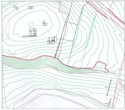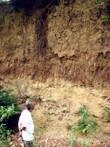|
|
| Geoarchaeology |
Geoarchaeology combines elements from the sciences of archaeology and geology in order to detect and investigate the natural and human factors that affect archaeological layers either on the level of the site or on the level of the landscape. Depending on the scale of the research, it can be divided into two categories:
- geomorphology, which refers to the investigation of the landscape, and
- micromorphology, which refers to the microscopic study of the archaeological deposits uncovered during the excavation.
|
| |
| Geomorphology - The history of the landscape |
Alongside the excavation at Paliambela, geomorphological surveys are being conducted in the area around the site in order to reconstruct the geological changes that have taken place over the centuries.  They in the main include the investigation of the surrounding area and the localisation of points where elements of geological transformations (weathering, alluviation, soil formation, etc.) can be discerned. In addition, test trenches have been opened with the aim of understanding the geological events that have led to the modern morphology of the broader landscape, and of detecting the remains of human activity outside the site. The geomorphological study of the area has already shed light on the changes undergone by the streams that surrounded the archaeological area in the past, on important geological events in the area (e.g. floods), on the initial extent of the prehistoric settlement and on the history of the weathering of the archaeological site. The help of the older inhabitants of the village, who have pointed out some of the subtler changes in the landscape, has also been important. They in the main include the investigation of the surrounding area and the localisation of points where elements of geological transformations (weathering, alluviation, soil formation, etc.) can be discerned. In addition, test trenches have been opened with the aim of understanding the geological events that have led to the modern morphology of the broader landscape, and of detecting the remains of human activity outside the site. The geomorphological study of the area has already shed light on the changes undergone by the streams that surrounded the archaeological area in the past, on important geological events in the area (e.g. floods), on the initial extent of the prehistoric settlement and on the history of the weathering of the archaeological site. The help of the older inhabitants of the village, who have pointed out some of the subtler changes in the landscape, has also been important. |
| |
Micromorphology - Investigating the
excavation stratigraphy |
The micromorphological study of the archaeological deposits supplements the recording of the stratigraphic observations made during the excavation.
It involves the collection of soil samples from various points in the excavated space and their laboratory analysis using a microscope, under which observations are made concerning the physical and chemical composition of the various deposits, their chromatic differences, the way in which one layer was deposited above another, the included particles of material (inclusions), as well as the organic remains and micro-finds. The aim of this analysis is to understand the formation conditions of the particular layer. The conclusions made are valuable for the distinction of various stratigraphic phases that are invisible to the naked eye. |
| |
| Geoarchaeology |
 The combination of the findings from the geomorphological and micromorphological studies contributes to the understanding of the prehistoric site as a single entity made up of various natural and human events that have left their mark on the archaeological layers, and also as part of a wider ecosystem that is in a constant state of change. In this sense it broadens the scale of archaeological investigation, offering data that is not easily detected by excavation alone, and it is important as regards the way in which humans interact with the environment in which they live and act. The combination of the findings from the geomorphological and micromorphological studies contributes to the understanding of the prehistoric site as a single entity made up of various natural and human events that have left their mark on the archaeological layers, and also as part of a wider ecosystem that is in a constant state of change. In this sense it broadens the scale of archaeological investigation, offering data that is not easily detected by excavation alone, and it is important as regards the way in which humans interact with the environment in which they live and act. |
|
|





